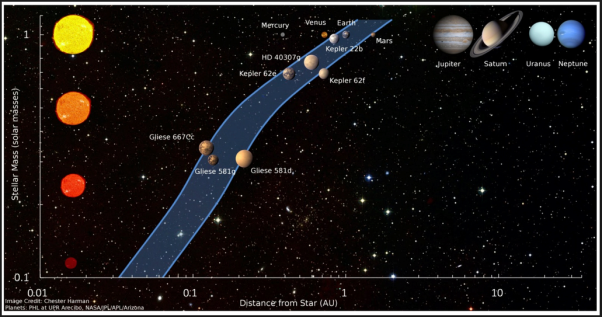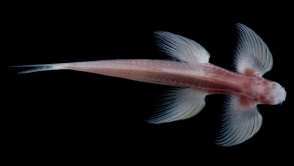Implications of the TRAPPIST-1 Discovery
| ✅ Paper Type: Free Essay | ✅ Subject: Physics |
| ✅ Wordcount: 2839 words | ✅ Published: 11 Sep 2017 |
The Search for Extra-Terrestrial Life in the Universe and the Implications of the TRAPPIST-1 Discovery
Abstract
Despite the absence of any discovery of life beyond the Earth in the Solar System, or communication in the form of radio signals from beyond the Solar System, humankind’s quest to answer the question whether there is life elsewhere in the Universe continues apace. The answer to the question could be tantalizingly close now with some ambitious missions being planned in the Solar System to try and find life itself, and surveys of unprecedented scale being conducted with space and terrestrial telescopes to identify potentially habitable exoplanets showing evidence for the existence of life. One such survey (the TRAPPIST survey) led to the discovery of a nearby solar system with a dwarf star at its centre, and in February this year the existence of seven Earth-sized planets orbiting the star was confirmed, with at least three lying in the habitable zone. Studies are continuing to see if there is evidence for the existence of life on any of these planets, with profound astronomical implications. This dissertation considers the question of what is life, before reviewing the history and future of the search for extra-terrestrial life in the Universe. The techniques employed and the results from the TRAPPIST survey are reviewed and the implications of the follow-on studies that are now planned are discussed. It concludes by considering the question whether humankind will ever encounter intelligent life in the Universe.

Thomas Zurbuchen
Associate administrator of the Science Mission Directorate at NASA speaking at the press briefing about the TRAPPIST-1 exoplanets in February 2017
The Search for Extra-Terrestrial Life in the Universe
Contents
5.History of the Search for Life Beyond Earth
The Search for Extra-Terrestrial Life in the Universe
Despite the absence of any discovery of life beyond the Earth in the Solar System, or communication in the form of radio signals from beyond the Solar System, humankind’s quest to answer the question whether there is life elsewhere in the Universe continues apace. Exobiology – the search for life or for evidence of it – has been stimulated by the extraordinary success of missions to planets and other bodies in the Solar System and the rapid advances that have been made in telescope technology in recent decades. The answer to the question could be tantalizingly close now with some ambitious missions being planned in the Solar System to try and find life itself, and surveys of unprecedented scale being conducted with space and terrestrial telescopes to identify potentially habitable exoplanets showing evidence for the existence of life.
One such survey (the TRAPPIST survey) led to the discovery of a nearby solar system with a dwarf star at its centre, and in February this year the existence of seven Earth-sized planets orbiting the star was confirmed, with at least three lying in the habitable zone. Studies are continuing to see if there is evidence for the existence of life on any of these planets, with profound astronomical implications.
This dissertation considers the question of what is life, before reviewing the history and future of the search for extra-terrestrial life in the Universe. The techniques employed and the results from the TRAPPIST survey are reviewed and the implications of the follow-on studies that are now planned are discussed. It concludes by considering the question whether humankind will ever encounter intelligent life in the Universe.
Is there life elsewhere in the universe?
Before setting out to answer that question we need to understand what we mean by “life”. In popular culture extra-terrestrial life is usually characterised by intelligent humanoid creatures with whom mankind can interact and communicate, but one only has to look at the diversity of life on Earth to appreciate that there are countless life forms, each unique and a product of the environment it inhabits. Nor can all life forms on Earth necessarily be described as “intelligent”, perhaps as defined by the Oxford Concise Dictionary:
“The ability to acquire and apply knowledge and skills”.
It is reasonable to assume that an ability to communicate is essential if a species is to be described as intelligent, but intelligence is not a pre-requisite for the development of life.
There are many scientific definitions of “life”, such as that offered by the Merriam-Webster Dictionary;
“An organismic state characterized by capacity for metabolism, growth, reaction to stimuli, and reproduction”.
This definition is helpful but it does not explicitly recognise that the ability to evolve, particularly in a changing environment, is vital for the development of sustainable life.
Mankind has expended considerable effort over the millennia trying to understand the cosmos. The ancients saw it as a place inhabited by the gods, but as astronomy developed, and with it our understanding of the Solar System and the Universe, we began to ask the question, “Are we alone?”, or perhaps more precisely, “Are there others out there like us?” Perhaps the question we have been seeking to answer should really have been in two parts; “Is there life elsewhere in the universe, and if so is it intelligent and would we be able to interact with it in some way?”
Earth is the only place where it is possible today to study living things and fossils to understand life, its evolution and the habitats where it can thrive.
On Earth life is found in many extreme environments including; around volcanic vents on the mid-ocean ridges; in deeply-buried porous sedimentary rocks (Bruckner, 2017); permanently in caves; in glacier ice (Edwards, 2014); in thermal springs; in the stratosphere (Major, 2016) and in naturally toxic environments that would be poisonous to most other life forms. Despite the abundance of life on the surface of the Earth it has been suggested that there may even be more life below the surface than there is above (Cox, 2013).
|
Figure 1: Colony of Deepsea Tube Worms and other fauna at the Galapagos Rift. (Photo: NOAA 2011 Galapagos Rift Expedition) |
Figure 2: A loach, a permanent cave-dwelling fish that crawls out of the water to feed on bacteria growing on damp rocks. (Photo: Danté Fenolio) |
All terrestrial life exhibits metabolism, which is a chemical process to harvest energy from the environment to maintain the living state of the cells that make up an organism. Metabolism involves moving and breaking down nutrients in order to produce energy to synthesize new proteins, nucleic acids etc. that are essential to sustain life (Dr Ananya Mandal, 2013).
All terrestrial life is based on the carbon atom, which can form chemical bonds to create the long and complex organic molecules that are the essential building blocks for life (Freeman, 2011). All terrestrial life is also reliant on liquid water as the medium within which the metabolic process occurs. Without liquid water there can be no metabolism and therefore no life, as demonstrated by the Atacama Desert – the driest place on Earth – where there is no evidence for the existence of any living organisms (Cox, 2013).
It is generally accepted that the pre-requisites for life are;
- Access to nutrients that contain the chemical elements necessary for life;
- An energy source that can be harvested directly or indirectly; and
- Liquid water.
Given that all elements occur throughout the Universe, as do stars that emit energy in the form of photons, the most obvious place to look for extra-terrestrial life is on the surface of planets where there is likely to be liquid water.
In any solar system there will be a region around the star within which the temperature is such that water will exist as a liquid. This is known as the “Habitable Zone”. The distance of the habitable zone from the star and its extent will be a function of the spectral type (and therefore mass) of the star and can be estimated using the Inverse Square Law, assuming the existence of an atmosphere with sufficient density to prevent sublimation of the water. The figure below shows the extent of the habitable zone for various star masses, with the Solar System planets and the exoplanets orbiting the red dwarf star Gliese 581 superimposed.

Figure 3: The habitable zone as a function of stellar mass and distance from the star
(Chester Harman, Planets: PHL at UPR Arecibo, NASA/JPL/APL/Arizona)
Another potential habitat for life is on the moons of large planets with elliptical orbits are subjected to tidal heating caused by tidal friction. Orbital and rotational energy is dissipated as heat in the crust of the moon, in some cases melting the ice and forming an ocean beneath the ice crust. Two known examples of this in the Solar System are Jupiter’s moon Europa and Saturn’s moon Enceladus.
It is postulated that life could also exist below the surface of Jupiter’s moon Io where there is plentiful heat to keep any water that was trapped in a liquid state, and where living organisms would be protected from Jupiter’s radiation (Choi, 2010).
- The Origin and Evolution of Life on Earth and Elsewhere
Through the study of living organisms the pre-requisites for life are reasonably well understood, as is the evolutionary process through inter alia the study of fossils. However, to answer the question of how life came to be established on Earth it is also necessary to look beyond the Earth for clues.
The elements that make up organic molecules are very abundant in the Universe and are known to originate from non-biological processes (e.g. volcanic activity on Mars (Carnegie Instution, 2012)) and there is a lot of evidence to suggest organic molecules are widespread in the galaxy, e.g.:
- Iso-propyl cyanide has been detected by examining microwave emission lines in inter-stellar clouds in the Milky Way (BBC, 2014).
- Organic molecules have been detected using spectral analysis in the tails of comets. The Rosetta mission to comet 67P/Churyumov-Gerasimenko also detected organic molecules (ESA, 2016).
- Organic molecules have also been found in certain types of meteorite collected on Earth. Carbonaceous chondrites are rare meteorites that have not melted at any stage of their life so are thought to pre-date the Solar System. They contain substantial amounts of carbon, including complex organic compounds and occasionally amino acids, and up to 20% water (Freeman, 2011).
In the early Solar System comets and meteorides were very numerous and according to the Panspermia Hypothesis they seeded the Universe with simple life forms that got trapped in ejecta thrown into space when collisions occurred between planets and moons. This theory was given credence when living bacteria was found in a sealed camera recovered and brought back to Earth by the Apollo 12 astronauts from the Surveyor 3 spacecraft. Surveyor 3 had been on the lunar surface for three years.
Another possibility is that organic molecules were formed on Earth, as hypothesised by Oparin and Haldane (Oparin, 1924). In 1952 Miller and Urey conducted their famous laboratory experiment which simulated conditions on early Earth. They mixed water, ammonia, methane and hydrogen in an atmosphere of water vapour, through which electric sparks were fired regularly to simulate lightening. At the end of the experiment they discovered that amino acids had indeed formed, giving credence to this hypothesis (Miller, 1953).

Figure 4: The Miller-Uray apparatus
Once all the right ingredients were present something “kick-started” life on Earth, and/or elsewhere in the Universe if the Panspermia Hypothesis is right. It is not possible today to conclude how life originated on Earth, but in any event the fossil record shows that the first simple living organisms appeared on Earth around 3.8 billion years ago, and so began the process of evolution producing the incredible diversity of life on Earth today.
Whether life was kick-started on Earth or arrived from elsewhere is arguably one of the most important factors influencing the possible distribution of extra-terrestrial life, and is discussed again in Section xx.
NASA was established by an act of the US Congress in 1958, mainly in response to the launch by the Soviet Union of Sputnik 1. Most of its efforts were initially concentrated on the development of manned and unmanned space flight, but in the 1970’s exploration of the Solar System using scientific probes began, driven to a large extent by the search for life beyond Earth.
NASA began a broad-based effort to learn how to look for the presence – both ancient and current – of life beyond Earth, giving birth to a new science which became known as Exobiology. The fundamental questions that NASA set out to answer were;
- What is needed for life to thrive?
- How does life evolve?
- Where else in the Universe could it have evolved?
- How do we find it?
In time it was acknowledged that to help answer these questions the detailed study of life on Earth was necessary to understand the origins and evolution of life and the habitats where it is found. The scope of exobiology expanded and it became known as Astrobiology (Freeman, 2011).
During the 1960’s a number of European countries started to get involved in space exploration, eventually clubbing together to form the European Space Agency (ESA) in 1975, bringing more resources to the exploration effort.
- The Search for Evidence of Intelligent Life
In 1959 Guiseppe Cocconi and Philip Morrison observed that if intelligent extra-terrestrial life had been attempting to communicate it would probably have been doing so using radio waves transmitted at the wavelength of neutral hydrogen (21.1 cm), which is in a region of the radio spectrum dubbed the “water hole” due to its proximity to the hydrogen and hydroxyl radical spectral line. These radio waves do not experience diminution when they travel through the interstellar medium or through the Earth’s atmosphere and they argued that it should therefore be possible to detect such signals with terrestrial radio telescopes because (Cocconi & Morrison, 1959).
In 1960 Dr Frank Drake used the radio telescope at the National Astronomy Observatory in West Virginia to search for four months for radio signals with a wavelength of 21.1 cm emanating from the vicinity of nearby stars Epsilon Eridani and Tau Ceti (Drake, 1961). He failed to detect any signals but this heralded the beginning of SETI (the Search for Extra-Terrestrial Intelligence). Since the 1980s there has been an international collaborative effort to detect meaningful signals across an increasingly wide range of wavelengths, but although occasional signals have been detected they have not been sustained or repeated, which suggests they were not produced by an intelligent life form seeking to communicate. Notwithstanding this, the search continues.
- The Search for Suitable Habitats and Evidence for the Existence of Life

Aristotle was the first to observe life in snow as a snow algal bloom. These occur as algae produce reddish-pink blooms (“watermelon snow”) as seen in this sample of Svalbard snow. The reddish-pink pigments are a microbial sunscreen, protecting the algae from UV radiation. Photo credit: Dr Arwyn Edwards (Edwards, 2014)
Drake
Stars w/ mass > 1.5o unlikely to support life – humans took 4bn + yrs
Small stars – long life but low temp, planets have to be close but then gravity locked
v. low POS based on current understanding = sun-like star- low rate of formation; 1:10 w/ habitable zone
Implications of Trappist-1 – results and historical assumptions
- The Probability of There Being Extra-Terrestrial Life in the Universe
The Drake Equation
The Drake equation is:
N = Râˆ- â‹… fp â‹… ne â‹… fâ„“ â‹… fi â‹… fc â‹… L
where:
N = the number of civilizations in our galaxy with which communication might be possible (i.e. which are on our current past light cone);
and
R* = the average rate of star formation in our galaxy
fp = the fraction of those stars that have planets
ne = the average number of planets that can potentially support life per star that has planets
fl = the fraction of planets that could support life that actually develop life at some point
fi = the fraction of planets with life that actually go on to develop intelligent life (civilizations)
fc = the fraction of civilizations that develop a technology that releases detectable signs of their existence into space
L = the length of time for which such civilizations release detectable signals into space
No table of figures entries found.
2. Prof BBC. (2014). Complex organic molecule found in interstellar space.
Bruckner, M. (2017). Endoliths-Microbes Living within Rocks. Microbial Life.
Carnegie Instution. (2012). Organic carbon from Mars, but not biological. Science Daily.
Cox, P. B. (2013). Wonders of the Solar System.
Dr Ananya Mandal, M. (2013). What is Metabolism?
Edwards, D. A. (2014). Glacier Ecosystems. Antarctic Glaciers.
ESA. (2016). Rosetta’s comet contains ingredients for life.
Freeman, R. (2011). Universe – Ninth Edition.
J. Mayo Greenberg, C. X.-G. (1992). The seeding of life by comets. Advances in Space Research.
Major, J. (2016). Hunting for High Life: What Lives in Earth’s Stratosphere? Universe Today.
Oparin, A. I. (1924). The Origin Of Life.
The Oxford Concise Dictionary. (n.d.).
- http://www.news-medical.net/life-sciences/What-is-Metabolism.aspx
- https://www.sciencedaily.com/releases/2012/05/120524143450.htm
- https://en.wikipedia.org/wiki/Panspermia
https://history.nasa.gov/factsheet.htm
https://astrobiology.nasa.gov/about/history-of-astrobiology/
http://www.esa.int/About_Us/Welcome_to_ESA/ESA_history/History_of_Europe_in_space
Ken Rice : “The Detection and Characterization of Extrasolar Planets”; Published: 19 September 2014
Cite This Work
To export a reference to this article please select a referencing stye below:
Related Services
View allDMCA / Removal Request
If you are the original writer of this essay and no longer wish to have your work published on UKEssays.com then please click the following link to email our support team:
Request essay removal




